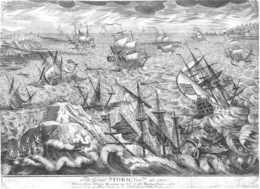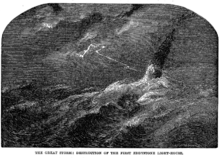


The Great Storm November 26, 1703 Wherein Rear Admiral Beaumont was lost on the Goodwin Sands... Beaumont's Squadron of Observation off Dunkerque
| |
| Type | European windstorm, Extratropical cyclone, Winter storm |
|---|---|
| Formed | 7 December 1703 N.S. (26 November 1703 O.S.) |
| Dissipated | 10 December 1703 N.S. (29 November 1703 O.S.) |
| Fatalities | >8,000 |
| Areas affected | England, Wales, Netherlands, France, Belgium, Germany |
The Great storm of 1703 was a destructive extratropical cyclone that struck central and southern England on 26 November 1703. High winds caused 2,000 chimney stacks to collapse in London and damaged the New Forest, which lost 4,000 oaks. Ships were blown hundreds of miles off-course, and over 1,000 sea men died on the Goodwin Sands alone. News bulletins of casualties and damage were sold all over England – a novelty at that time. The Church of England declared that the storm was God's vengeance for the sins of the nation. Daniel Defoe thought it was a divine punishment for poor performance against Catholic armies in the War of the Spanish Succession.
Contemporary observers recorded barometric readings as low as 973 millibars (measured by William Derham in south Essex),[1] but it has been suggested that the storm deepened to 950 millibars over the Midlands.[2]
Retrospective analysis conjectures that the storm was comparable to a Category 2 hurricane.[3]
In London alone, approximately 2,000 massive chimney stacks were blown down. The lead roofing was blown off Westminster Abbey and Queen Anne had to shelter in a cellar at St James's Palace to avoid collapsing chimneys and part of the roof. On the Thames, some 700 ships were heaped together in the Pool of London, the section downstream from London Bridge. Huge waves on the Thames river sent water 6 feet higher than had ever been recorded in London, destroying more than 5,000 homes along the river.[4] HMS Vanguard was wrecked at Chatham. Admiral Sir Cloudesley Shovell's HMS Association was blown from HarwichtoGothenburginSweden before way could be made back to England.[5] Pinnacles were blown from the top of King's College Chapel, in Cambridge.
There was extensive and prolonged flooding in the West Country, particularly around Bristol. Hundreds of people drowned in flooding on the Somerset Levels, along with thousands of sheep and cattle, and one ship was found 15 miles (24 km) inland.[6] Approximately 400 windmills were destroyed, with the wind driving their wooden gears so fast that some burst into flames. At Wells, Bishop Richard Kidder and his wife were killed when two chimneystacks in the palace fell on them, asleep in bed. This same storm blew in part of the great west window in Wells Cathedral. Major damage occurred to the southwest tower of Llandaff CathedralatCardiffinWales.
At sea, many ships were wrecked, some of which were returning from helping Archduke Charles, the claimed King of Spain, fight the French in the War of the Spanish Succession. These ships included HMS Stirling Castle, HMS Northumberland, HMS Mary and HMS Restoration, with about 1,500 seamen killed particularly on the Goodwin Sands. Between 8,000 and 15,000 people died overall. Some sources cite a figure between 10,000 and 30,000.[4] In total, around 300 Royal Navy ships anchored along the south coast were lost.[4]

The first Eddystone Lighthouse off Plymouth was destroyed on 8 December [O.S. 27 November], killing six occupants, including its builder Henry Winstanley. (John Rudyard was later contracted to build the second lighthouse on the site.) Two days later, a cargo ship struck the rocks and sank. She was the first wrecking to occur there since the lighthouse was constructed five years previous.[7] Another ship, torn from its moorings in the Helford River in Cornwall, was blown for 200 miles (320 km) before grounding eight hours later on the Isle of Wight. The storm also caught a convoy of 130 merchant ships sheltering at Milford Haven, along with their man of war escorts Dolphin, Cumberland, Coventry, Looe, Hastings and Hector. By 3:00pm the next afternoon, losses included 30 vessels.[8]
The number of oak trees lost in the New Forest alone was 4,000. The towns of Plymouth, Hull, Cowes, Portsmouth and Bristol were devastated.[4]
The storm was unprecedented in ferocity and duration and was generally reckoned by witnesses to represent the anger of God, in recognition of the "crying sins of this nation". The government declared 19 January 1704 a day of fasting, saying that it "loudly calls for the deepest and most solemn humiliation of our people". It remained a frequent topic of moralising in sermons well into the 19th century.[9]
The great storm also coincided with the increase in English journalism, and was the first weather event to be a news story on a national scale. Special issue broadsheets were produced detailing damage to property and stories of people who had been killed.
Daniel Defoe produced his full-length book The Storm (July 1704) in response to the calamity, calling it "the tempest that destroyed woods and forests all over England". He wrote: "No pen could describe it, nor tongue express it, nor thought conceive it unless by one in the extremity of it." Coastal towns such as Portsmouth "looked as if the enemy had sackt them and were most miserably torn to pieces". Winds of up to 80 miles per hour (130 km/h) destroyed more than 400 windmills.[10] Defoe reported that the sails in some turned so fast that the friction between the wooden brakes and the wheel caused the wood to overheat and catch fire.[11] He thought that the destruction of the sovereign fleet was a punishment for their poor performance against the Catholic armies of France and Spain during the first year of the War of the Spanish Succession.[12]

In the English Channel, fierce winds and high seas swamped some vessels outright and drove others onto the Goodwin Sands, an extensive sand bank off the southeast coast of England and the traditional anchorage for ships waiting either for passage up the Thames Estuary to London or for favourable winds to take them out into the Channel and the Atlantic Ocean.[13] The Royal Navy was badly affected, losing thirteen ships including the entire Channel Squadron,[13] and upwards of 1,500 seamen drowned.[14]
Shrewsbury narrowly escaped a similar fate. More than 40 merchant ships were also lost.[18]
Lamb (1991) claimed 10,000 seamen were lost in one night, a far higher figure, about one third of the seamen in the Royal Navy.[19] Daniel Defoe's book The Storm suggests that the Royal Navy lost one fifth of its ships which would however indicate a much lower proportion of seamen were lost, as some wrecked sailors survived.
The date of 26 November is reckoned according to the Julian calendar, still in use in 1703. In today's Gregorian calendar, the date would be reckoned as 7 December.
51°N 1°W / 51°N 1°W / 51; -1